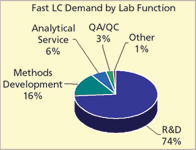Market Profile: Fast Liquid Chromatography
The market for high performance liquid chromatography (HPLC) continues to be one of the most dynamic markets of the analytical instruments industry. A few years ago, the HPLC market began showing signs of maturity with little product innovation and slower growth rates. Although innovations in mass spectrometry (MS) helped to fuel growth, HPLC was an afterthought and considered to be a mere inlet to MS. However, the recent development of fast liquid chromatography (LC) systems is energizing the HPLC market.
The market for high performance liquid chromatography (HPLC) continues to be one of the most dynamic markets of the analytical instruments industry. A few years ago, the HPLC market began showing signs of maturity with little product innovation and slower growth rates. Although innovations in mass spectrometry (MS) helped to fuel growth, HPLC was an afterthought and considered to be a mere inlet to MS. However, the recent development of fast liquid chromatography (LC) systems is energizing the HPLC market.

Fast liquid chromatography demand by laboratory function.
Although most major HPLC vendors now have fast LC capabilities, the methods used to achieve fast separations differ. Product and technological comparisons to determine the best system is difficult to surmise because there are numerous variables to be considered. There are benefits for each platform, and the weights of the variables vary depending on the application and the user.
Fast LC purveyors offer many choices. Customers can choose a dedicated unit, simply select the fast LC option, or add a module to an existing HPLC. Pricing also varies depending on the vendor and model selection. Likewise, column technology can be proprietary or "open system," thus, cost of ownership can be an issue depending on utilization rates. And while fast LC systems offer significant improvements in performance, there are differences between each offering that must be matched to application requirements.
Nevertheless, the use of fast LC systems are certainly increasing due to several obvious benefits like throughput, sensitivity, and resolution. SDi estimates R&D labs currently account for the majority of the fast LC market. In particular, high throughput R&D labs are benefiting from the advantages of fast LC technologies.
Fast LC increases lab productivity. Faster analysis means fewer disruptions in the laboratory workflow because sample can be quickly re-run if an error is discovered. Fast LC methods are designed for shorter runtimes. Vendors have exhibited runtimes that are 40 times faster than standard HPLC. Shorter runtimes also provide another benefit: faster method development. Users can reduce the optimization process of their methods simply because they can string more runs in a day.
The foregoing data was extracted and adapted from Instrument Business Outlook, an SDi publication, and SDi's Global Assessment Report, 9th Edition. For more information, contact Glenn Cudiamat, VP of Research Services, Strategic Directions International, Inc., 6242 Westchester Parkway, Suite 100, Los Angeles, CA 90045, tel. (310) 641-4982, fax (310) 641-8851, e-mail: cudiamat@strategic-directions.com
Investigating 3D-Printable Stationary Phases in Liquid Chromatography
May 7th 20253D printing technology has potential in chromatography, but a major challenge is developing materials with both high porosity and robust mechanical properties. Recently, scientists compared the separation performances of eight different 3D printable stationary phases.
Characterizing Polyamides Using Reversed-Phase Liquid Chromatography
May 5th 2025Polyamides can be difficult to characterize, despite their use in various aspects of everyday life. Vrije Universiteit Amsterdam researchers hoped to address this using a reversed-phase liquid chromatography (RPLC)-based approach.
New Method Explored for the Detection of CECs in Crops Irrigated with Contaminated Water
April 30th 2025This new study presents a validated QuEChERS–LC-MS/MS method for detecting eight persistent, mobile, and toxic substances in escarole, tomatoes, and tomato leaves irrigated with contaminated water.
University of Tasmania Researchers Explore Haloacetic Acid Determiniation in Water with capLC–MS
April 29th 2025Haloacetic acid detection has become important when analyzing drinking and swimming pool water. University of Tasmania researchers have begun applying capillary liquid chromatography as a means of detecting these substances.

.png&w=3840&q=75)

.png&w=3840&q=75)



.png&w=3840&q=75)



.png&w=3840&q=75)













